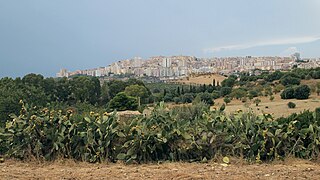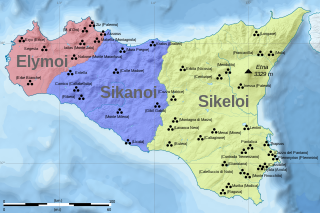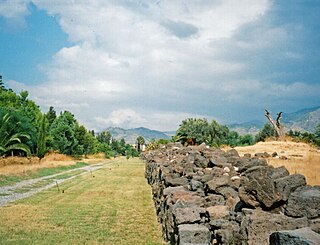
The Dorians were one of the four major ethnic groups into which the Hellenes of Classical Greece divided themselves. They are almost always referred to as just "the Dorians", as they are called in the earliest literary mention of them in the Odyssey, where they already can be found inhabiting the island of Crete.

Sicily is the largest and most populous island in the Mediterranean Sea and one of the 20 regions of Italy. The Strait of Messina divides it from the region of Calabria in Southern Italy. It is one of the five Italian autonomous regions and is officially referred to as Regione Siciliana. The region has 5 million inhabitants. Its capital city is Palermo.

The Greeks or Hellenes are an ethnic group and nation indigenous to Greece, Cyprus, southern Albania, Anatolia, parts of Italy and Egypt, and to a lesser extent, other countries surrounding the Eastern Mediterranean and Black Sea. They also form a significant diaspora, with many Greek communities established around the world.

Agrigento is a city on the southern coast of Sicily, Italy and capital of the province of Agrigento. It was one of the leading cities of Magna Graecia during the golden age of Ancient Greece.

Magna Graecia was the name given by the Romans to the coastal areas of Southern Italy in the present-day Italian regions of Calabria, Apulia, Basilicata, Campania and Sicily; these regions were extensively populated by Greek settlers. These settlers, who began arriving in the 8th century BC, brought with them their Hellenic civilization, which left a lasting imprint on Italy. They also influenced the native peoples, such as the Sicels and the Oenotrians, who became hellenized after they adopted the Greek culture as their own.

Thurii, called also by some Latin writers Thurium, for a time also Copia and Copiae, was a city of Magna Graecia, situated on the Tarentine gulf, within a short distance of the site of Sybaris, whose place it may be considered as having taken. The ruins of the city can be found in the Sybaris archaeological park near Sibari in the Province of Cosenza, Calabria, Italy.

Diodorus Siculus, or Diodorus of Sicily was an ancient Greek historian. He is known for writing the monumental universal history Bibliotheca historica, in forty books, fifteen of which survive intact, between 60 and 30 BC. The history is arranged in three parts. The first covers mythic history up to the destruction of Troy, arranged geographically, describing regions around the world from Egypt, India and Arabia to Europe. The second covers the time from the Trojan War to the death of Alexander the Great. The third covers the period to about 60 BC. Bibliotheca, meaning 'library', acknowledges that he was drawing on the work of many other authors.

The Sicels were an Indo-European tribe who inhabited eastern Sicily during the Iron Age. Their neighbours to the west were the Sicani. The Sicels gave Sicily the name that it has held since antiquity, but they rapidly fused into the culture of Magna Graecia.

Southern Italy, also known as Meridione or Mezzogiorno is a macroregion of Italy consisting of its southern regions.

Griko, sometimes spelled Grico, is the dialect of Italiot Greek spoken by Griko people in Salento and in Calabria. Some Greek linguists consider it to be a Modern Greek dialect and often call it Katoitaliótika or Grekanika (Γραικάνικα), whereas its own speakers call it Greko or Griko. Griko is spoken in Salento while Greko is spoken in Calabria. Griko and Standard Modern Greek are partially mutually intelligible.

Sicilians, or the Sicilian people, are a Romance-speaking ethnic group who are indigenous to the island of Sicily, the largest island in the Mediterranean Sea, as well as the largest and most populous of the autonomous regions of Italy.

Apollonia was an Ancient Greek trade colony which developed into an independent polis, and later a Roman city, in southern Illyria. It was located on the right bank of the Aoös/Vjosë river, approximately 10 km from the eastern coast of the Adriatic Sea. Its ruins are situated in the county of Fier, close to the village of Pojan, in Albania.

The Greeks have been identified by many ethnonyms. The most common native ethnonym is Hellen, pl. Hellenes (Ἕλληνες); the name Greeks was used by the ancient Romans and gradually entered the European languages through its use in Latin. The mythological patriarch Hellen is the named progenitor of the Greek peoples; his descendants the Aeolians, Dorians, Achaeans and Ionians correspond to the main Greek tribes and to the main dialects spoken in Greece and Asia Minor (Anatolia).

Naxos or Naxus was an ancient Greek city, presently situated in modern Giardini Naxos near Taormina on the east coast of Sicily.

San Fratello, formerly San Filadelfo, is a comune (municipality) in the Metropolitan City of Messina in the Italian region Sicily, located about 110 kilometres (68 mi) east of Palermo and about 90 kilometres (56 mi) west of Messina. San Fratello borders the following municipalities: Acquedolci, Alcara li Fusi, Caronia, Cesarò, Militello Rosmarino, Sant'Agata di Militello.

Greek presence in Italy began with the migrations of traders and colonial foundations in the 8th century BC, continuing down to the present time. Nowadays, there is an ethnic minority known as the Griko people, who live in the Southern Italian regions of Calabria and Apulia, especially the peninsula of Salento, within the ancient Magna Graecia region, who speak a distinctive dialect of Greek called Griko. They are believed to be remnants of the ancient and medieval Greek communities, who have lived in the south of Italy for centuries. A Greek community has long existed in Venice as well, the current centre of the Greek Orthodox Archdiocese of Italy and Malta, which in addition was a Byzantine province until the 10th century and held territory in Morea and Crete until the 17th century. Alongside this group, a smaller number of more recent migrants from Greece lives in Italy, forming an expatriate community in the country. Today many Greeks in Southern Italy follow Italian customs and culture, experiencing assimilation.

Diplomatic relations between Algeria and Greece date back for more than 2000 years. Diplomatic relations have been solid since Algeria's first years of independence. Greece maintains an embassy in Algiers, and Algeria is represented in Greece by its embassy in Athens. Trade between Greece and Algeria is increasing, with imports of natural gas from Algeria an important factor. There have been problems with illegal immigration from Algeria to Greece in recent years, and with Algerian trafficking of Sub Saharan Africans seeking to enter the European Union.

Sicilian nationalism, or Sicilianism, is a movement in the autonomous Italian region of Sicily, as well as the Sicilian diaspora, which seeks greater autonomy or outright independence from Italy, and/or promotes further inclusion of the Sicilian identity, culture, history, and linguistic variety.

The Hellenic Museum is an art and history museum in Melbourne, Victoria, Australia dedicated to inspiring visitors about Hellenic culture, both ancient and contemporary, through innovative programs, exhibitions and events.

Greek coinage of Italy and Sicily originated from local Italiotes and Siceliotes who formed numerous city states. These Hellenistic communities descended from Greek migrants. Southern Italy was so thoroughly hellenized that it was known as the Magna Graecia. Each of the polities struck their own coinage.

















